Enhancing Teacher Development Through Reflective Practices
VerifiedAdded on 2023/06/12
|19
|6125
|101
Essay
AI Summary
This essay delves into the concept of reflective teaching as a means of teacher development, examining the beliefs and practices within the classroom. It emphasizes the importance of self-examination and continuous learning through experiences and actions. The essay discusses the benefits of reflective practices, including improved teaching skills, enhanced knowledge, and the ability to identify strengths and weaknesses. It explores various models of reflective practice, such as Gibbs' Reflective Cycle, Johns' Model of Reflection, and Brookfield's Critical Lenses, detailing their stages and applications. Furthermore, the essay differentiates between reflection in action and reflection on action, highlighting their respective roles in decision-making and knowledge acquisition. Ultimately, the essay underscores the value of reflective practices in fostering professional growth and improving teaching effectiveness, with Desklib offering further resources and solved assignments for students.
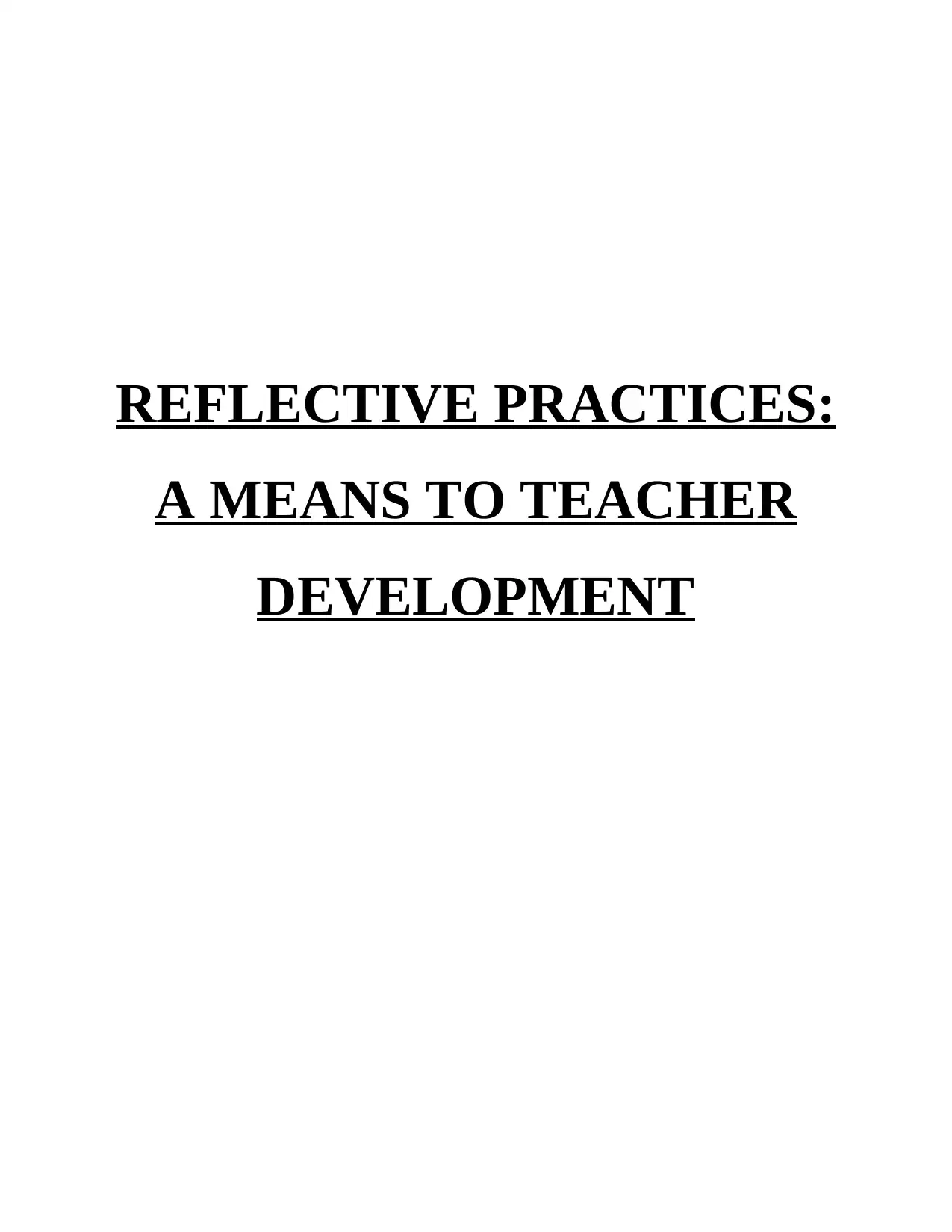
REFLECTIVE PRACTICES:
A MEANS TO TEACHER
DEVELOPMENT
A MEANS TO TEACHER
DEVELOPMENT
Paraphrase This Document
Need a fresh take? Get an instant paraphrase of this document with our AI Paraphraser
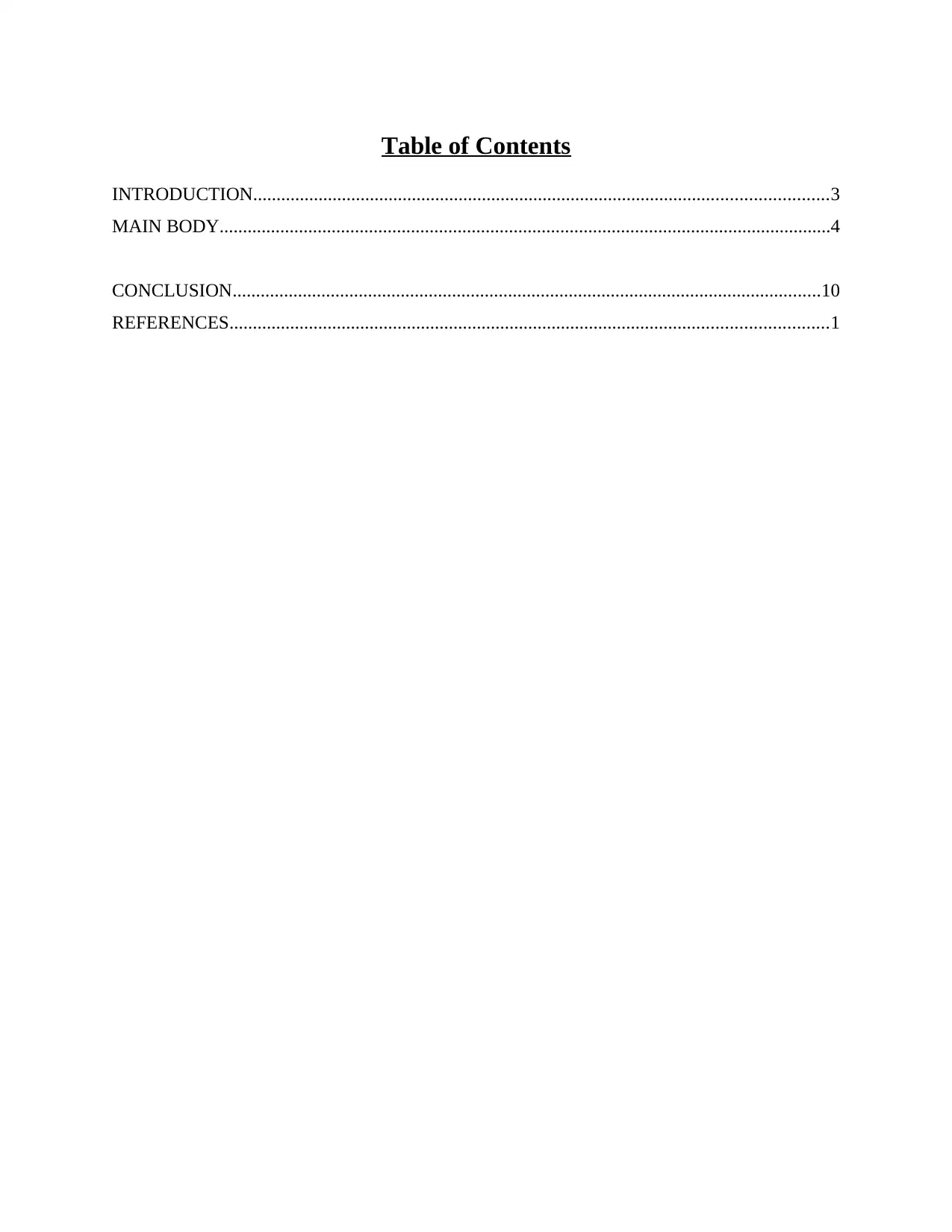
Table of Contents
INTRODUCTION...........................................................................................................................3
MAIN BODY...................................................................................................................................4
CONCLUSION..............................................................................................................................10
REFERENCES................................................................................................................................1
INTRODUCTION...........................................................................................................................3
MAIN BODY...................................................................................................................................4
CONCLUSION..............................................................................................................................10
REFERENCES................................................................................................................................1
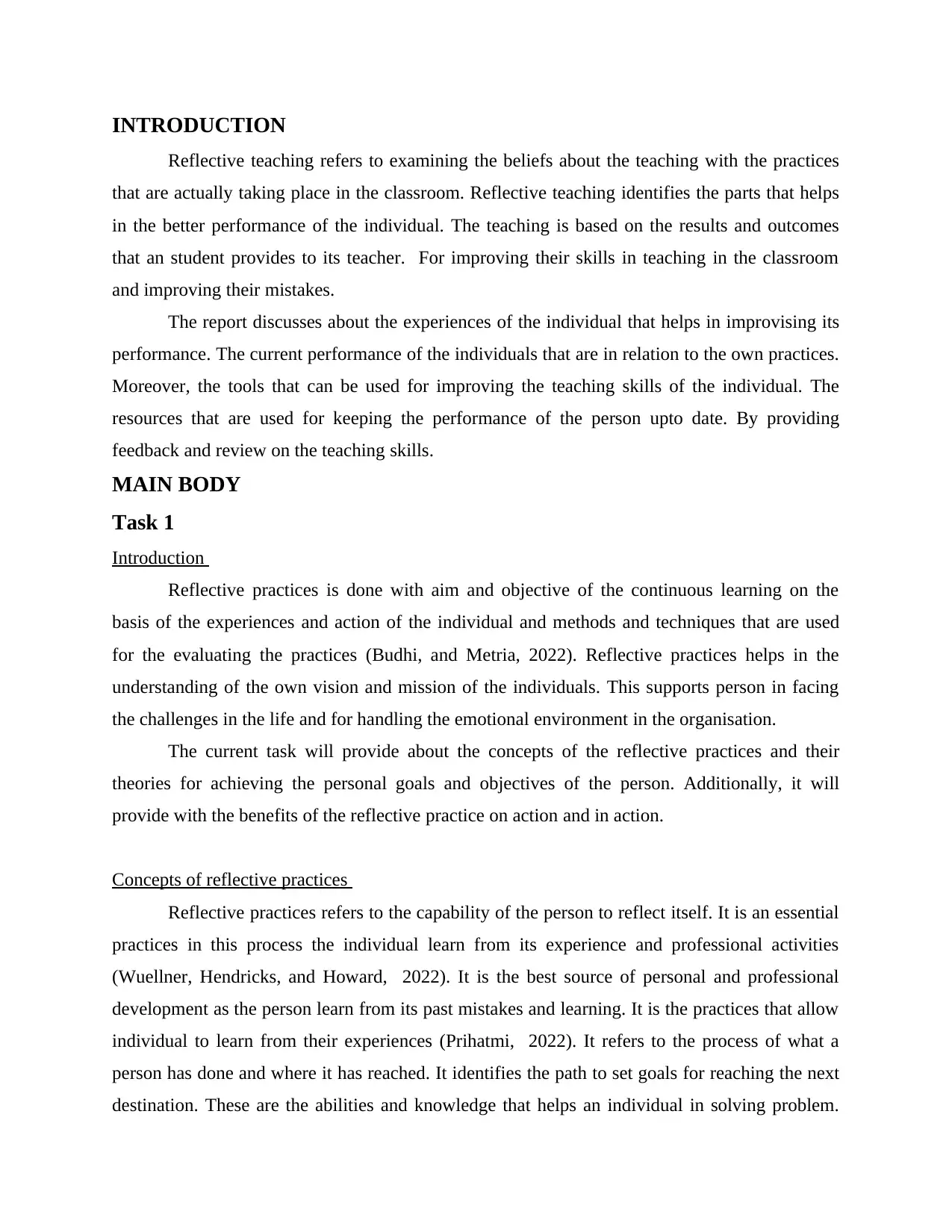
INTRODUCTION
Reflective teaching refers to examining the beliefs about the teaching with the practices
that are actually taking place in the classroom. Reflective teaching identifies the parts that helps
in the better performance of the individual. The teaching is based on the results and outcomes
that an student provides to its teacher. For improving their skills in teaching in the classroom
and improving their mistakes.
The report discusses about the experiences of the individual that helps in improvising its
performance. The current performance of the individuals that are in relation to the own practices.
Moreover, the tools that can be used for improving the teaching skills of the individual. The
resources that are used for keeping the performance of the person upto date. By providing
feedback and review on the teaching skills.
MAIN BODY
Task 1
Introduction
Reflective practices is done with aim and objective of the continuous learning on the
basis of the experiences and action of the individual and methods and techniques that are used
for the evaluating the practices (Budhi, and Metria, 2022). Reflective practices helps in the
understanding of the own vision and mission of the individuals. This supports person in facing
the challenges in the life and for handling the emotional environment in the organisation.
The current task will provide about the concepts of the reflective practices and their
theories for achieving the personal goals and objectives of the person. Additionally, it will
provide with the benefits of the reflective practice on action and in action.
Concepts of reflective practices
Reflective practices refers to the capability of the person to reflect itself. It is an essential
practices in this process the individual learn from its experience and professional activities
(Wuellner, Hendricks, and Howard, 2022). It is the best source of personal and professional
development as the person learn from its past mistakes and learning. It is the practices that allow
individual to learn from their experiences (Prihatmi, 2022). It refers to the process of what a
person has done and where it has reached. It identifies the path to set goals for reaching the next
destination. These are the abilities and knowledge that helps an individual in solving problem.
Reflective teaching refers to examining the beliefs about the teaching with the practices
that are actually taking place in the classroom. Reflective teaching identifies the parts that helps
in the better performance of the individual. The teaching is based on the results and outcomes
that an student provides to its teacher. For improving their skills in teaching in the classroom
and improving their mistakes.
The report discusses about the experiences of the individual that helps in improvising its
performance. The current performance of the individuals that are in relation to the own practices.
Moreover, the tools that can be used for improving the teaching skills of the individual. The
resources that are used for keeping the performance of the person upto date. By providing
feedback and review on the teaching skills.
MAIN BODY
Task 1
Introduction
Reflective practices is done with aim and objective of the continuous learning on the
basis of the experiences and action of the individual and methods and techniques that are used
for the evaluating the practices (Budhi, and Metria, 2022). Reflective practices helps in the
understanding of the own vision and mission of the individuals. This supports person in facing
the challenges in the life and for handling the emotional environment in the organisation.
The current task will provide about the concepts of the reflective practices and their
theories for achieving the personal goals and objectives of the person. Additionally, it will
provide with the benefits of the reflective practice on action and in action.
Concepts of reflective practices
Reflective practices refers to the capability of the person to reflect itself. It is an essential
practices in this process the individual learn from its experience and professional activities
(Wuellner, Hendricks, and Howard, 2022). It is the best source of personal and professional
development as the person learn from its past mistakes and learning. It is the practices that allow
individual to learn from their experiences (Prihatmi, 2022). It refers to the process of what a
person has done and where it has reached. It identifies the path to set goals for reaching the next
destination. These are the abilities and knowledge that helps an individual in solving problem.
⊘ This is a preview!⊘
Do you want full access?
Subscribe today to unlock all pages.

Trusted by 1+ million students worldwide
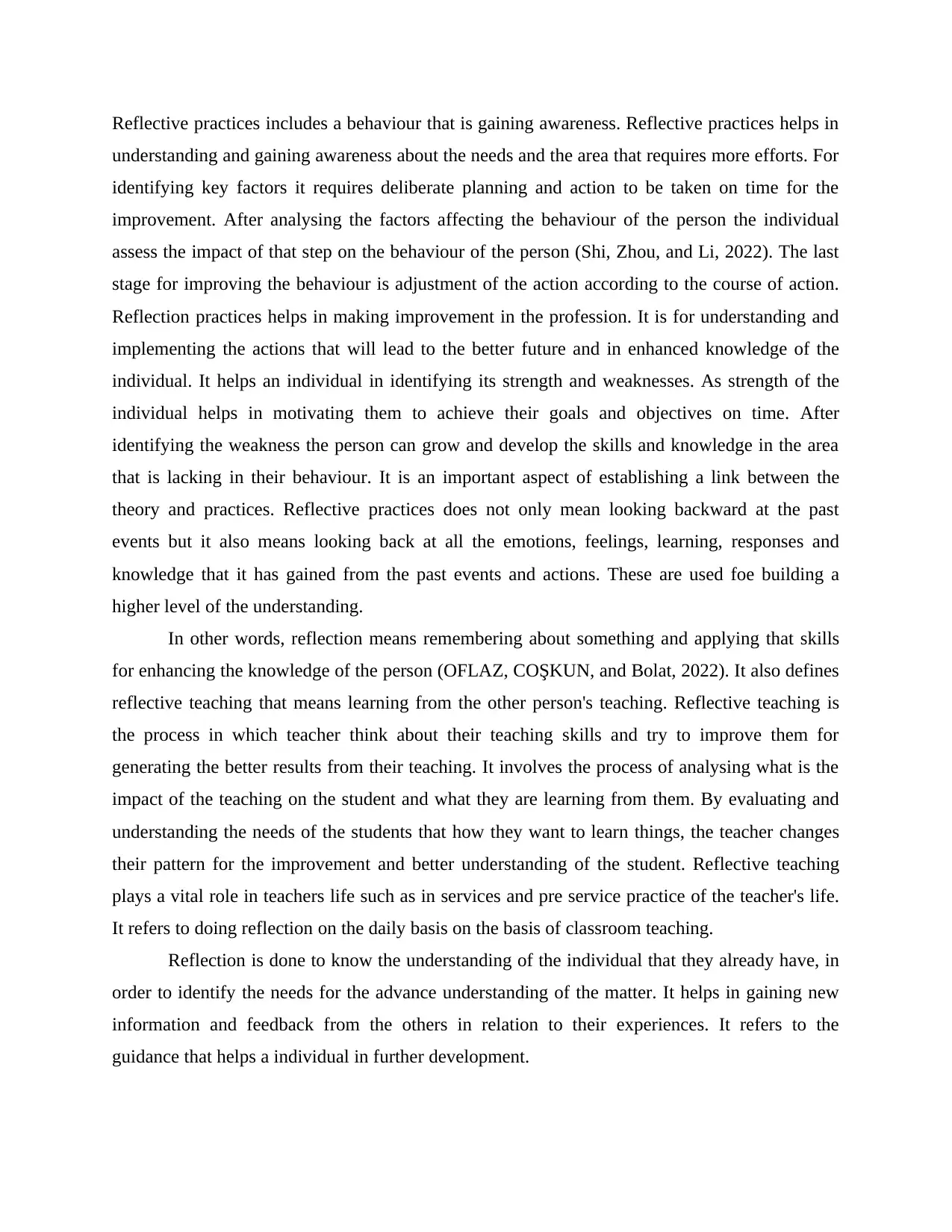
Reflective practices includes a behaviour that is gaining awareness. Reflective practices helps in
understanding and gaining awareness about the needs and the area that requires more efforts. For
identifying key factors it requires deliberate planning and action to be taken on time for the
improvement. After analysing the factors affecting the behaviour of the person the individual
assess the impact of that step on the behaviour of the person (Shi, Zhou, and Li, 2022). The last
stage for improving the behaviour is adjustment of the action according to the course of action.
Reflection practices helps in making improvement in the profession. It is for understanding and
implementing the actions that will lead to the better future and in enhanced knowledge of the
individual. It helps an individual in identifying its strength and weaknesses. As strength of the
individual helps in motivating them to achieve their goals and objectives on time. After
identifying the weakness the person can grow and develop the skills and knowledge in the area
that is lacking in their behaviour. It is an important aspect of establishing a link between the
theory and practices. Reflective practices does not only mean looking backward at the past
events but it also means looking back at all the emotions, feelings, learning, responses and
knowledge that it has gained from the past events and actions. These are used foe building a
higher level of the understanding.
In other words, reflection means remembering about something and applying that skills
for enhancing the knowledge of the person (OFLAZ, COŞKUN, and Bolat, 2022). It also defines
reflective teaching that means learning from the other person's teaching. Reflective teaching is
the process in which teacher think about their teaching skills and try to improve them for
generating the better results from their teaching. It involves the process of analysing what is the
impact of the teaching on the student and what they are learning from them. By evaluating and
understanding the needs of the students that how they want to learn things, the teacher changes
their pattern for the improvement and better understanding of the student. Reflective teaching
plays a vital role in teachers life such as in services and pre service practice of the teacher's life.
It refers to doing reflection on the daily basis on the basis of classroom teaching.
Reflection is done to know the understanding of the individual that they already have, in
order to identify the needs for the advance understanding of the matter. It helps in gaining new
information and feedback from the others in relation to their experiences. It refers to the
guidance that helps a individual in further development.
understanding and gaining awareness about the needs and the area that requires more efforts. For
identifying key factors it requires deliberate planning and action to be taken on time for the
improvement. After analysing the factors affecting the behaviour of the person the individual
assess the impact of that step on the behaviour of the person (Shi, Zhou, and Li, 2022). The last
stage for improving the behaviour is adjustment of the action according to the course of action.
Reflection practices helps in making improvement in the profession. It is for understanding and
implementing the actions that will lead to the better future and in enhanced knowledge of the
individual. It helps an individual in identifying its strength and weaknesses. As strength of the
individual helps in motivating them to achieve their goals and objectives on time. After
identifying the weakness the person can grow and develop the skills and knowledge in the area
that is lacking in their behaviour. It is an important aspect of establishing a link between the
theory and practices. Reflective practices does not only mean looking backward at the past
events but it also means looking back at all the emotions, feelings, learning, responses and
knowledge that it has gained from the past events and actions. These are used foe building a
higher level of the understanding.
In other words, reflection means remembering about something and applying that skills
for enhancing the knowledge of the person (OFLAZ, COŞKUN, and Bolat, 2022). It also defines
reflective teaching that means learning from the other person's teaching. Reflective teaching is
the process in which teacher think about their teaching skills and try to improve them for
generating the better results from their teaching. It involves the process of analysing what is the
impact of the teaching on the student and what they are learning from them. By evaluating and
understanding the needs of the students that how they want to learn things, the teacher changes
their pattern for the improvement and better understanding of the student. Reflective teaching
plays a vital role in teachers life such as in services and pre service practice of the teacher's life.
It refers to doing reflection on the daily basis on the basis of classroom teaching.
Reflection is done to know the understanding of the individual that they already have, in
order to identify the needs for the advance understanding of the matter. It helps in gaining new
information and feedback from the others in relation to their experiences. It refers to the
guidance that helps a individual in further development.
Paraphrase This Document
Need a fresh take? Get an instant paraphrase of this document with our AI Paraphraser
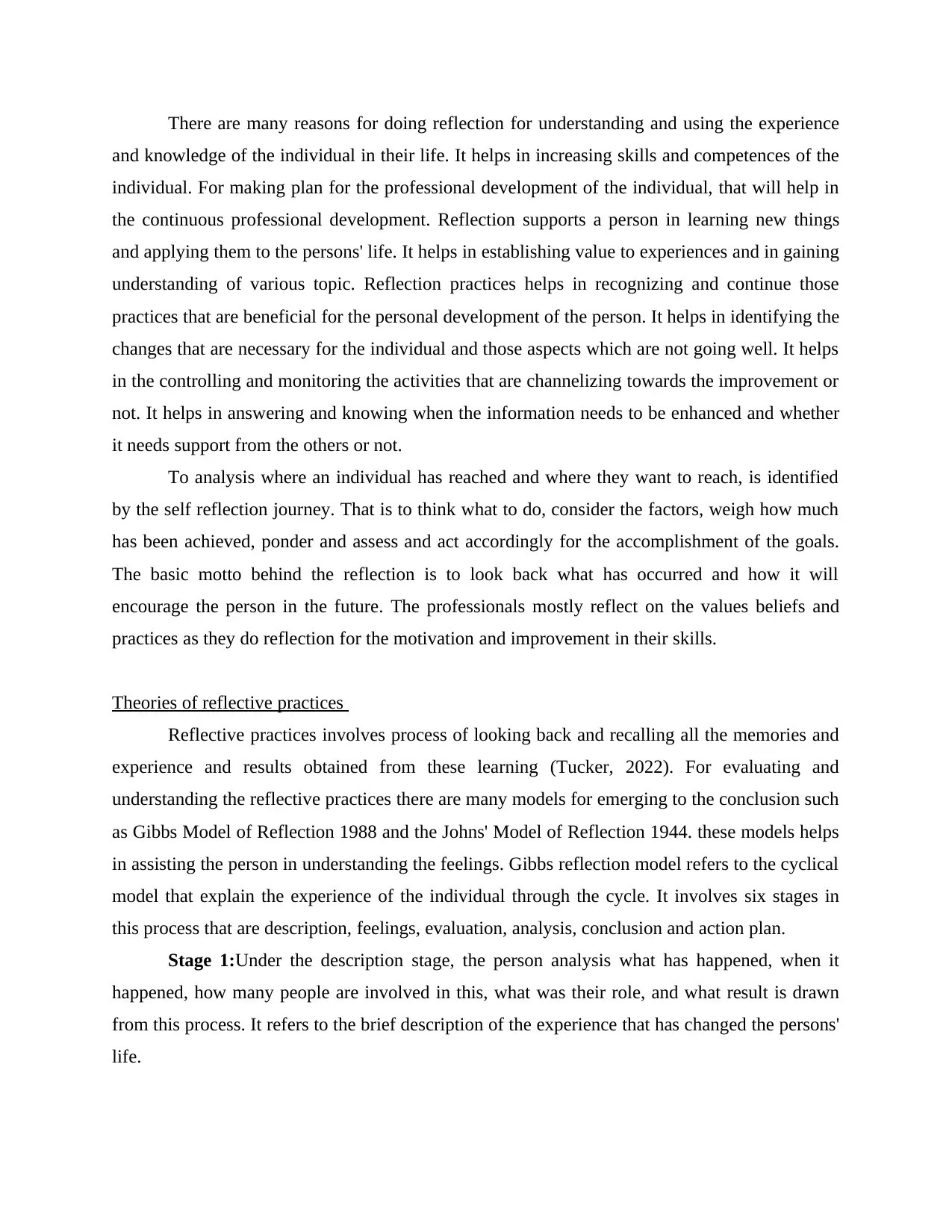
There are many reasons for doing reflection for understanding and using the experience
and knowledge of the individual in their life. It helps in increasing skills and competences of the
individual. For making plan for the professional development of the individual, that will help in
the continuous professional development. Reflection supports a person in learning new things
and applying them to the persons' life. It helps in establishing value to experiences and in gaining
understanding of various topic. Reflection practices helps in recognizing and continue those
practices that are beneficial for the personal development of the person. It helps in identifying the
changes that are necessary for the individual and those aspects which are not going well. It helps
in the controlling and monitoring the activities that are channelizing towards the improvement or
not. It helps in answering and knowing when the information needs to be enhanced and whether
it needs support from the others or not.
To analysis where an individual has reached and where they want to reach, is identified
by the self reflection journey. That is to think what to do, consider the factors, weigh how much
has been achieved, ponder and assess and act accordingly for the accomplishment of the goals.
The basic motto behind the reflection is to look back what has occurred and how it will
encourage the person in the future. The professionals mostly reflect on the values beliefs and
practices as they do reflection for the motivation and improvement in their skills.
Theories of reflective practices
Reflective practices involves process of looking back and recalling all the memories and
experience and results obtained from these learning (Tucker, 2022). For evaluating and
understanding the reflective practices there are many models for emerging to the conclusion such
as Gibbs Model of Reflection 1988 and the Johns' Model of Reflection 1944. these models helps
in assisting the person in understanding the feelings. Gibbs reflection model refers to the cyclical
model that explain the experience of the individual through the cycle. It involves six stages in
this process that are description, feelings, evaluation, analysis, conclusion and action plan.
Stage 1:Under the description stage, the person analysis what has happened, when it
happened, how many people are involved in this, what was their role, and what result is drawn
from this process. It refers to the brief description of the experience that has changed the persons'
life.
and knowledge of the individual in their life. It helps in increasing skills and competences of the
individual. For making plan for the professional development of the individual, that will help in
the continuous professional development. Reflection supports a person in learning new things
and applying them to the persons' life. It helps in establishing value to experiences and in gaining
understanding of various topic. Reflection practices helps in recognizing and continue those
practices that are beneficial for the personal development of the person. It helps in identifying the
changes that are necessary for the individual and those aspects which are not going well. It helps
in the controlling and monitoring the activities that are channelizing towards the improvement or
not. It helps in answering and knowing when the information needs to be enhanced and whether
it needs support from the others or not.
To analysis where an individual has reached and where they want to reach, is identified
by the self reflection journey. That is to think what to do, consider the factors, weigh how much
has been achieved, ponder and assess and act accordingly for the accomplishment of the goals.
The basic motto behind the reflection is to look back what has occurred and how it will
encourage the person in the future. The professionals mostly reflect on the values beliefs and
practices as they do reflection for the motivation and improvement in their skills.
Theories of reflective practices
Reflective practices involves process of looking back and recalling all the memories and
experience and results obtained from these learning (Tucker, 2022). For evaluating and
understanding the reflective practices there are many models for emerging to the conclusion such
as Gibbs Model of Reflection 1988 and the Johns' Model of Reflection 1944. these models helps
in assisting the person in understanding the feelings. Gibbs reflection model refers to the cyclical
model that explain the experience of the individual through the cycle. It involves six stages in
this process that are description, feelings, evaluation, analysis, conclusion and action plan.
Stage 1:Under the description stage, the person analysis what has happened, when it
happened, how many people are involved in this, what was their role, and what result is drawn
from this process. It refers to the brief description of the experience that has changed the persons'
life.
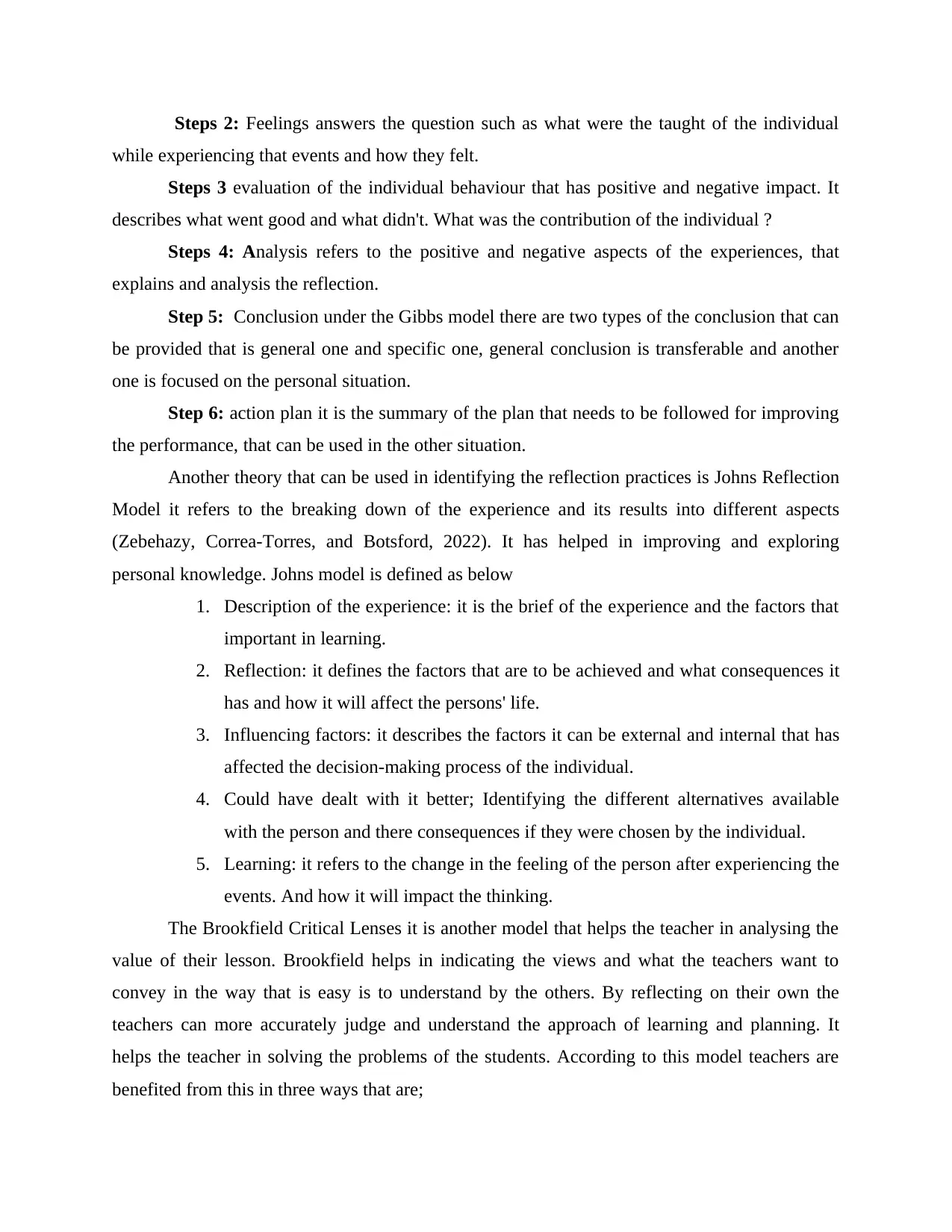
Steps 2: Feelings answers the question such as what were the taught of the individual
while experiencing that events and how they felt.
Steps 3 evaluation of the individual behaviour that has positive and negative impact. It
describes what went good and what didn't. What was the contribution of the individual ?
Steps 4: Analysis refers to the positive and negative aspects of the experiences, that
explains and analysis the reflection.
Step 5: Conclusion under the Gibbs model there are two types of the conclusion that can
be provided that is general one and specific one, general conclusion is transferable and another
one is focused on the personal situation.
Step 6: action plan it is the summary of the plan that needs to be followed for improving
the performance, that can be used in the other situation.
Another theory that can be used in identifying the reflection practices is Johns Reflection
Model it refers to the breaking down of the experience and its results into different aspects
(Zebehazy, Correa-Torres, and Botsford, 2022). It has helped in improving and exploring
personal knowledge. Johns model is defined as below
1. Description of the experience: it is the brief of the experience and the factors that
important in learning.
2. Reflection: it defines the factors that are to be achieved and what consequences it
has and how it will affect the persons' life.
3. Influencing factors: it describes the factors it can be external and internal that has
affected the decision-making process of the individual.
4. Could have dealt with it better; Identifying the different alternatives available
with the person and there consequences if they were chosen by the individual.
5. Learning: it refers to the change in the feeling of the person after experiencing the
events. And how it will impact the thinking.
The Brookfield Critical Lenses it is another model that helps the teacher in analysing the
value of their lesson. Brookfield helps in indicating the views and what the teachers want to
convey in the way that is easy is to understand by the others. By reflecting on their own the
teachers can more accurately judge and understand the approach of learning and planning. It
helps the teacher in solving the problems of the students. According to this model teachers are
benefited from this in three ways that are;
while experiencing that events and how they felt.
Steps 3 evaluation of the individual behaviour that has positive and negative impact. It
describes what went good and what didn't. What was the contribution of the individual ?
Steps 4: Analysis refers to the positive and negative aspects of the experiences, that
explains and analysis the reflection.
Step 5: Conclusion under the Gibbs model there are two types of the conclusion that can
be provided that is general one and specific one, general conclusion is transferable and another
one is focused on the personal situation.
Step 6: action plan it is the summary of the plan that needs to be followed for improving
the performance, that can be used in the other situation.
Another theory that can be used in identifying the reflection practices is Johns Reflection
Model it refers to the breaking down of the experience and its results into different aspects
(Zebehazy, Correa-Torres, and Botsford, 2022). It has helped in improving and exploring
personal knowledge. Johns model is defined as below
1. Description of the experience: it is the brief of the experience and the factors that
important in learning.
2. Reflection: it defines the factors that are to be achieved and what consequences it
has and how it will affect the persons' life.
3. Influencing factors: it describes the factors it can be external and internal that has
affected the decision-making process of the individual.
4. Could have dealt with it better; Identifying the different alternatives available
with the person and there consequences if they were chosen by the individual.
5. Learning: it refers to the change in the feeling of the person after experiencing the
events. And how it will impact the thinking.
The Brookfield Critical Lenses it is another model that helps the teacher in analysing the
value of their lesson. Brookfield helps in indicating the views and what the teachers want to
convey in the way that is easy is to understand by the others. By reflecting on their own the
teachers can more accurately judge and understand the approach of learning and planning. It
helps the teacher in solving the problems of the students. According to this model teachers are
benefited from this in three ways that are;
⊘ This is a preview!⊘
Do you want full access?
Subscribe today to unlock all pages.

Trusted by 1+ million students worldwide
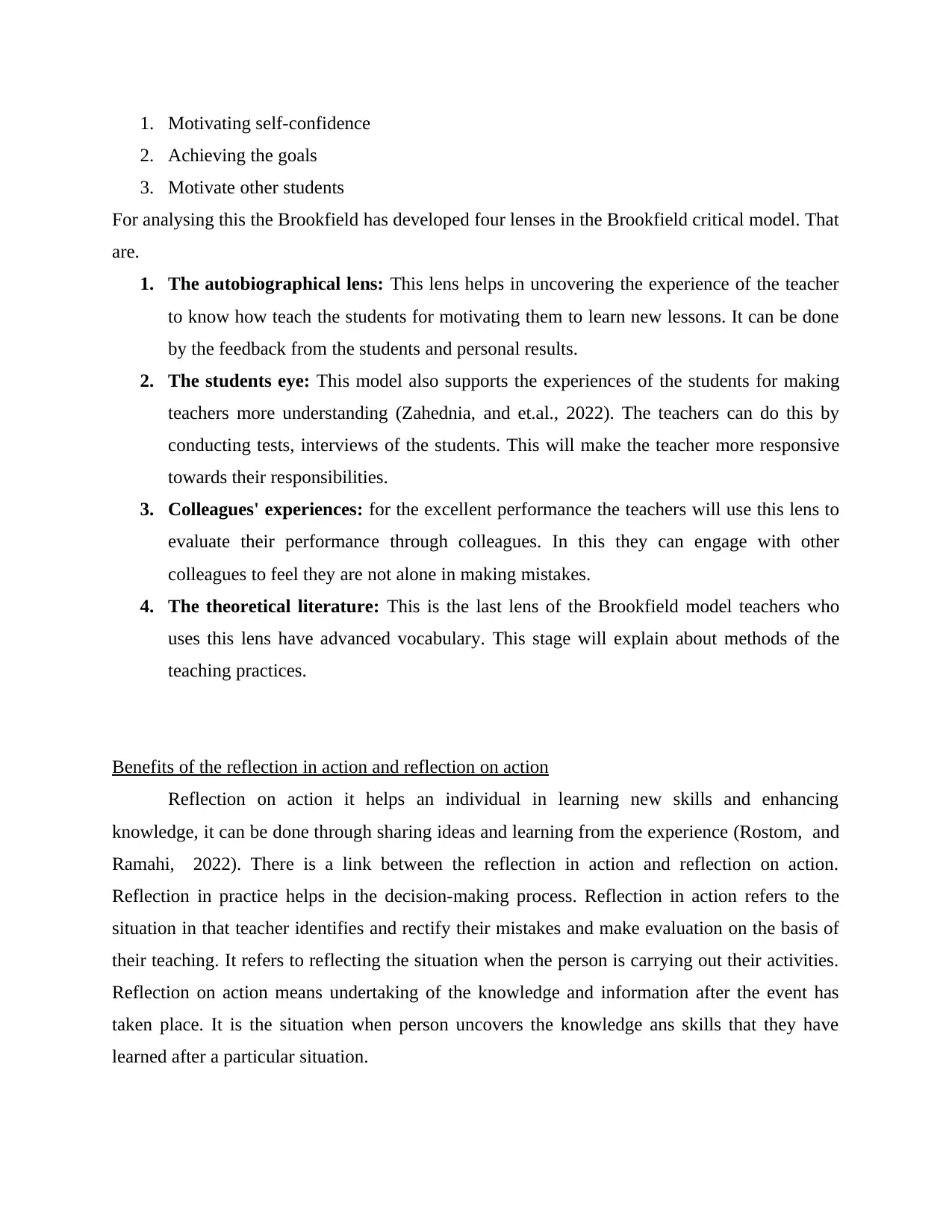
1. Motivating self-confidence
2. Achieving the goals
3. Motivate other students
For analysing this the Brookfield has developed four lenses in the Brookfield critical model. That
are.
1. The autobiographical lens: This lens helps in uncovering the experience of the teacher
to know how teach the students for motivating them to learn new lessons. It can be done
by the feedback from the students and personal results.
2. The students eye: This model also supports the experiences of the students for making
teachers more understanding (Zahednia, and et.al., 2022). The teachers can do this by
conducting tests, interviews of the students. This will make the teacher more responsive
towards their responsibilities.
3. Colleagues' experiences: for the excellent performance the teachers will use this lens to
evaluate their performance through colleagues. In this they can engage with other
colleagues to feel they are not alone in making mistakes.
4. The theoretical literature: This is the last lens of the Brookfield model teachers who
uses this lens have advanced vocabulary. This stage will explain about methods of the
teaching practices.
Benefits of the reflection in action and reflection on action
Reflection on action it helps an individual in learning new skills and enhancing
knowledge, it can be done through sharing ideas and learning from the experience (Rostom, and
Ramahi, 2022). There is a link between the reflection in action and reflection on action.
Reflection in practice helps in the decision-making process. Reflection in action refers to the
situation in that teacher identifies and rectify their mistakes and make evaluation on the basis of
their teaching. It refers to reflecting the situation when the person is carrying out their activities.
Reflection on action means undertaking of the knowledge and information after the event has
taken place. It is the situation when person uncovers the knowledge ans skills that they have
learned after a particular situation.
2. Achieving the goals
3. Motivate other students
For analysing this the Brookfield has developed four lenses in the Brookfield critical model. That
are.
1. The autobiographical lens: This lens helps in uncovering the experience of the teacher
to know how teach the students for motivating them to learn new lessons. It can be done
by the feedback from the students and personal results.
2. The students eye: This model also supports the experiences of the students for making
teachers more understanding (Zahednia, and et.al., 2022). The teachers can do this by
conducting tests, interviews of the students. This will make the teacher more responsive
towards their responsibilities.
3. Colleagues' experiences: for the excellent performance the teachers will use this lens to
evaluate their performance through colleagues. In this they can engage with other
colleagues to feel they are not alone in making mistakes.
4. The theoretical literature: This is the last lens of the Brookfield model teachers who
uses this lens have advanced vocabulary. This stage will explain about methods of the
teaching practices.
Benefits of the reflection in action and reflection on action
Reflection on action it helps an individual in learning new skills and enhancing
knowledge, it can be done through sharing ideas and learning from the experience (Rostom, and
Ramahi, 2022). There is a link between the reflection in action and reflection on action.
Reflection in practice helps in the decision-making process. Reflection in action refers to the
situation in that teacher identifies and rectify their mistakes and make evaluation on the basis of
their teaching. It refers to reflecting the situation when the person is carrying out their activities.
Reflection on action means undertaking of the knowledge and information after the event has
taken place. It is the situation when person uncovers the knowledge ans skills that they have
learned after a particular situation.
Paraphrase This Document
Need a fresh take? Get an instant paraphrase of this document with our AI Paraphraser
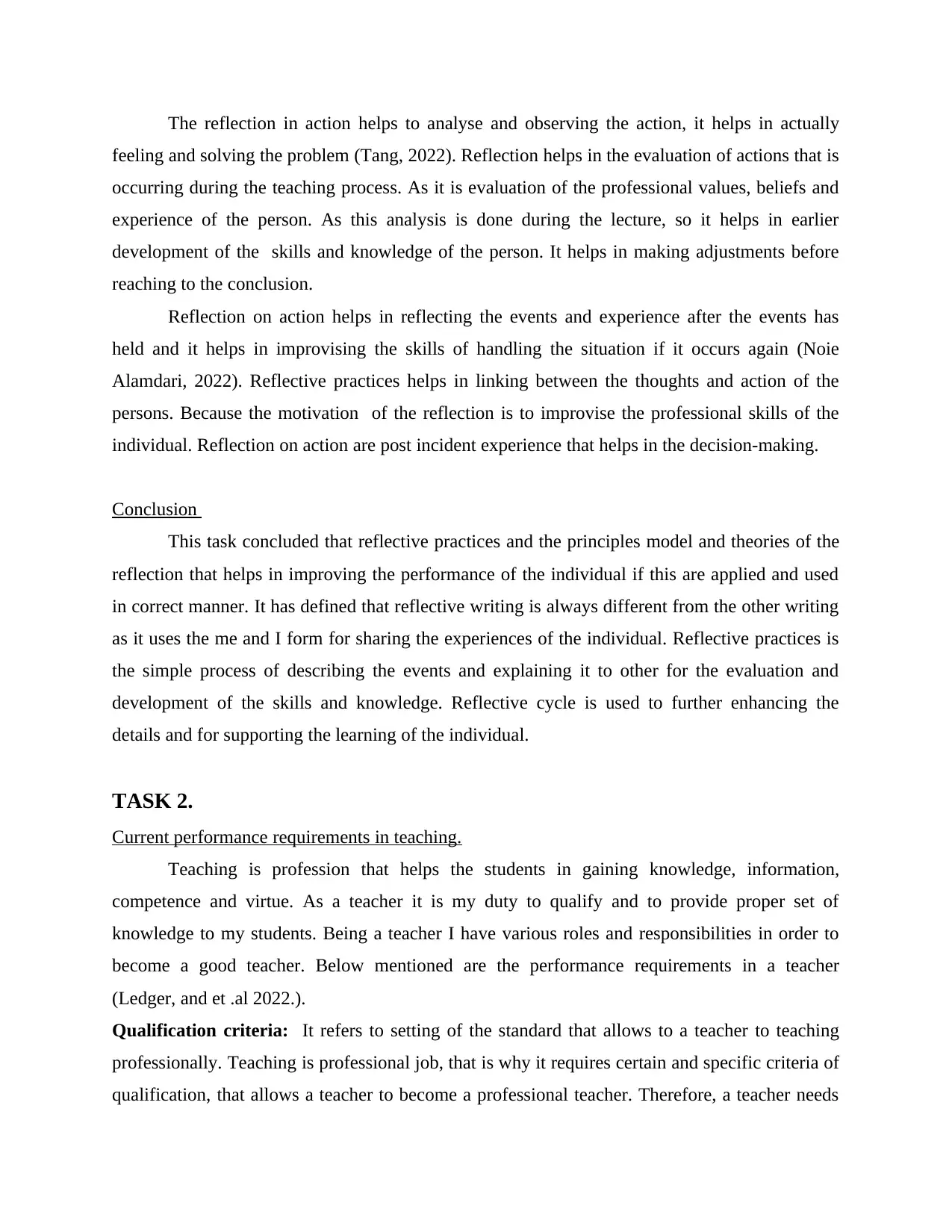
The reflection in action helps to analyse and observing the action, it helps in actually
feeling and solving the problem (Tang, 2022). Reflection helps in the evaluation of actions that is
occurring during the teaching process. As it is evaluation of the professional values, beliefs and
experience of the person. As this analysis is done during the lecture, so it helps in earlier
development of the skills and knowledge of the person. It helps in making adjustments before
reaching to the conclusion.
Reflection on action helps in reflecting the events and experience after the events has
held and it helps in improvising the skills of handling the situation if it occurs again (Noie
Alamdari, 2022). Reflective practices helps in linking between the thoughts and action of the
persons. Because the motivation of the reflection is to improvise the professional skills of the
individual. Reflection on action are post incident experience that helps in the decision-making.
Conclusion
This task concluded that reflective practices and the principles model and theories of the
reflection that helps in improving the performance of the individual if this are applied and used
in correct manner. It has defined that reflective writing is always different from the other writing
as it uses the me and I form for sharing the experiences of the individual. Reflective practices is
the simple process of describing the events and explaining it to other for the evaluation and
development of the skills and knowledge. Reflective cycle is used to further enhancing the
details and for supporting the learning of the individual.
TASK 2.
Current performance requirements in teaching.
Teaching is profession that helps the students in gaining knowledge, information,
competence and virtue. As a teacher it is my duty to qualify and to provide proper set of
knowledge to my students. Being a teacher I have various roles and responsibilities in order to
become a good teacher. Below mentioned are the performance requirements in a teacher
(Ledger, and et .al 2022.).
Qualification criteria: It refers to setting of the standard that allows to a teacher to teaching
professionally. Teaching is professional job, that is why it requires certain and specific criteria of
qualification, that allows a teacher to become a professional teacher. Therefore, a teacher needs
feeling and solving the problem (Tang, 2022). Reflection helps in the evaluation of actions that is
occurring during the teaching process. As it is evaluation of the professional values, beliefs and
experience of the person. As this analysis is done during the lecture, so it helps in earlier
development of the skills and knowledge of the person. It helps in making adjustments before
reaching to the conclusion.
Reflection on action helps in reflecting the events and experience after the events has
held and it helps in improvising the skills of handling the situation if it occurs again (Noie
Alamdari, 2022). Reflective practices helps in linking between the thoughts and action of the
persons. Because the motivation of the reflection is to improvise the professional skills of the
individual. Reflection on action are post incident experience that helps in the decision-making.
Conclusion
This task concluded that reflective practices and the principles model and theories of the
reflection that helps in improving the performance of the individual if this are applied and used
in correct manner. It has defined that reflective writing is always different from the other writing
as it uses the me and I form for sharing the experiences of the individual. Reflective practices is
the simple process of describing the events and explaining it to other for the evaluation and
development of the skills and knowledge. Reflective cycle is used to further enhancing the
details and for supporting the learning of the individual.
TASK 2.
Current performance requirements in teaching.
Teaching is profession that helps the students in gaining knowledge, information,
competence and virtue. As a teacher it is my duty to qualify and to provide proper set of
knowledge to my students. Being a teacher I have various roles and responsibilities in order to
become a good teacher. Below mentioned are the performance requirements in a teacher
(Ledger, and et .al 2022.).
Qualification criteria: It refers to setting of the standard that allows to a teacher to teaching
professionally. Teaching is professional job, that is why it requires certain and specific criteria of
qualification, that allows a teacher to become a professional teacher. Therefore, a teacher needs
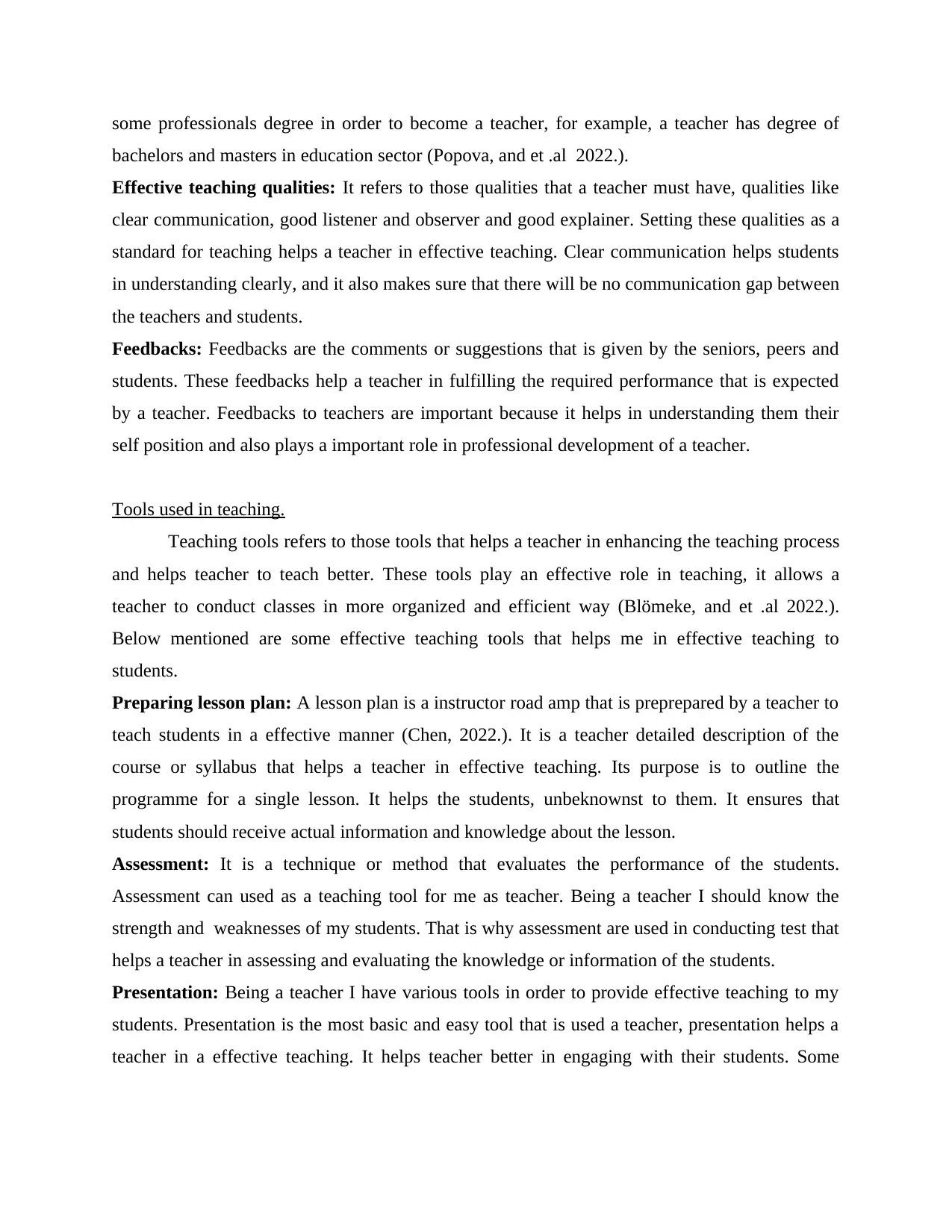
some professionals degree in order to become a teacher, for example, a teacher has degree of
bachelors and masters in education sector (Popova, and et .al 2022.).
Effective teaching qualities: It refers to those qualities that a teacher must have, qualities like
clear communication, good listener and observer and good explainer. Setting these qualities as a
standard for teaching helps a teacher in effective teaching. Clear communication helps students
in understanding clearly, and it also makes sure that there will be no communication gap between
the teachers and students.
Feedbacks: Feedbacks are the comments or suggestions that is given by the seniors, peers and
students. These feedbacks help a teacher in fulfilling the required performance that is expected
by a teacher. Feedbacks to teachers are important because it helps in understanding them their
self position and also plays a important role in professional development of a teacher.
Tools used in teaching.
Teaching tools refers to those tools that helps a teacher in enhancing the teaching process
and helps teacher to teach better. These tools play an effective role in teaching, it allows a
teacher to conduct classes in more organized and efficient way (Blömeke, and et .al 2022.).
Below mentioned are some effective teaching tools that helps me in effective teaching to
students.
Preparing lesson plan: A lesson plan is a instructor road amp that is preprepared by a teacher to
teach students in a effective manner (Chen, 2022.). It is a teacher detailed description of the
course or syllabus that helps a teacher in effective teaching. Its purpose is to outline the
programme for a single lesson. It helps the students, unbeknownst to them. It ensures that
students should receive actual information and knowledge about the lesson.
Assessment: It is a technique or method that evaluates the performance of the students.
Assessment can used as a teaching tool for me as teacher. Being a teacher I should know the
strength and weaknesses of my students. That is why assessment are used in conducting test that
helps a teacher in assessing and evaluating the knowledge or information of the students.
Presentation: Being a teacher I have various tools in order to provide effective teaching to my
students. Presentation is the most basic and easy tool that is used a teacher, presentation helps a
teacher in a effective teaching. It helps teacher better in engaging with their students. Some
bachelors and masters in education sector (Popova, and et .al 2022.).
Effective teaching qualities: It refers to those qualities that a teacher must have, qualities like
clear communication, good listener and observer and good explainer. Setting these qualities as a
standard for teaching helps a teacher in effective teaching. Clear communication helps students
in understanding clearly, and it also makes sure that there will be no communication gap between
the teachers and students.
Feedbacks: Feedbacks are the comments or suggestions that is given by the seniors, peers and
students. These feedbacks help a teacher in fulfilling the required performance that is expected
by a teacher. Feedbacks to teachers are important because it helps in understanding them their
self position and also plays a important role in professional development of a teacher.
Tools used in teaching.
Teaching tools refers to those tools that helps a teacher in enhancing the teaching process
and helps teacher to teach better. These tools play an effective role in teaching, it allows a
teacher to conduct classes in more organized and efficient way (Blömeke, and et .al 2022.).
Below mentioned are some effective teaching tools that helps me in effective teaching to
students.
Preparing lesson plan: A lesson plan is a instructor road amp that is preprepared by a teacher to
teach students in a effective manner (Chen, 2022.). It is a teacher detailed description of the
course or syllabus that helps a teacher in effective teaching. Its purpose is to outline the
programme for a single lesson. It helps the students, unbeknownst to them. It ensures that
students should receive actual information and knowledge about the lesson.
Assessment: It is a technique or method that evaluates the performance of the students.
Assessment can used as a teaching tool for me as teacher. Being a teacher I should know the
strength and weaknesses of my students. That is why assessment are used in conducting test that
helps a teacher in assessing and evaluating the knowledge or information of the students.
Presentation: Being a teacher I have various tools in order to provide effective teaching to my
students. Presentation is the most basic and easy tool that is used a teacher, presentation helps a
teacher in a effective teaching. It helps teacher better in engaging with their students. Some
⊘ This is a preview!⊘
Do you want full access?
Subscribe today to unlock all pages.

Trusted by 1+ million students worldwide
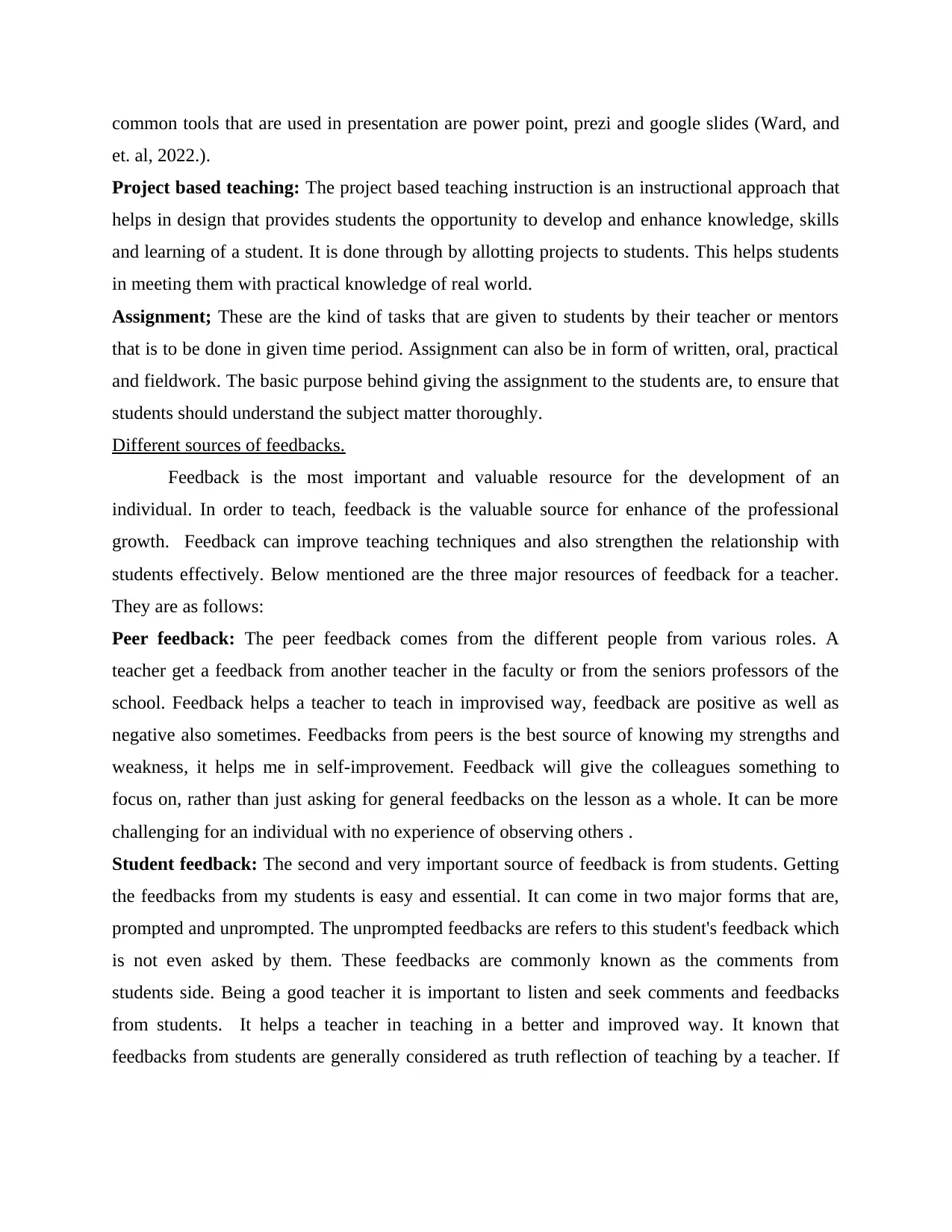
common tools that are used in presentation are power point, prezi and google slides (Ward, and
et. al, 2022.).
Project based teaching: The project based teaching instruction is an instructional approach that
helps in design that provides students the opportunity to develop and enhance knowledge, skills
and learning of a student. It is done through by allotting projects to students. This helps students
in meeting them with practical knowledge of real world.
Assignment; These are the kind of tasks that are given to students by their teacher or mentors
that is to be done in given time period. Assignment can also be in form of written, oral, practical
and fieldwork. The basic purpose behind giving the assignment to the students are, to ensure that
students should understand the subject matter thoroughly.
Different sources of feedbacks.
Feedback is the most important and valuable resource for the development of an
individual. In order to teach, feedback is the valuable source for enhance of the professional
growth. Feedback can improve teaching techniques and also strengthen the relationship with
students effectively. Below mentioned are the three major resources of feedback for a teacher.
They are as follows:
Peer feedback: The peer feedback comes from the different people from various roles. A
teacher get a feedback from another teacher in the faculty or from the seniors professors of the
school. Feedback helps a teacher to teach in improvised way, feedback are positive as well as
negative also sometimes. Feedbacks from peers is the best source of knowing my strengths and
weakness, it helps me in self-improvement. Feedback will give the colleagues something to
focus on, rather than just asking for general feedbacks on the lesson as a whole. It can be more
challenging for an individual with no experience of observing others .
Student feedback: The second and very important source of feedback is from students. Getting
the feedbacks from my students is easy and essential. It can come in two major forms that are,
prompted and unprompted. The unprompted feedbacks are refers to this student's feedback which
is not even asked by them. These feedbacks are commonly known as the comments from
students side. Being a good teacher it is important to listen and seek comments and feedbacks
from students. It helps a teacher in teaching in a better and improved way. It known that
feedbacks from students are generally considered as truth reflection of teaching by a teacher. If
et. al, 2022.).
Project based teaching: The project based teaching instruction is an instructional approach that
helps in design that provides students the opportunity to develop and enhance knowledge, skills
and learning of a student. It is done through by allotting projects to students. This helps students
in meeting them with practical knowledge of real world.
Assignment; These are the kind of tasks that are given to students by their teacher or mentors
that is to be done in given time period. Assignment can also be in form of written, oral, practical
and fieldwork. The basic purpose behind giving the assignment to the students are, to ensure that
students should understand the subject matter thoroughly.
Different sources of feedbacks.
Feedback is the most important and valuable resource for the development of an
individual. In order to teach, feedback is the valuable source for enhance of the professional
growth. Feedback can improve teaching techniques and also strengthen the relationship with
students effectively. Below mentioned are the three major resources of feedback for a teacher.
They are as follows:
Peer feedback: The peer feedback comes from the different people from various roles. A
teacher get a feedback from another teacher in the faculty or from the seniors professors of the
school. Feedback helps a teacher to teach in improvised way, feedback are positive as well as
negative also sometimes. Feedbacks from peers is the best source of knowing my strengths and
weakness, it helps me in self-improvement. Feedback will give the colleagues something to
focus on, rather than just asking for general feedbacks on the lesson as a whole. It can be more
challenging for an individual with no experience of observing others .
Student feedback: The second and very important source of feedback is from students. Getting
the feedbacks from my students is easy and essential. It can come in two major forms that are,
prompted and unprompted. The unprompted feedbacks are refers to this student's feedback which
is not even asked by them. These feedbacks are commonly known as the comments from
students side. Being a good teacher it is important to listen and seek comments and feedbacks
from students. It helps a teacher in teaching in a better and improved way. It known that
feedbacks from students are generally considered as truth reflection of teaching by a teacher. If
Paraphrase This Document
Need a fresh take? Get an instant paraphrase of this document with our AI Paraphraser
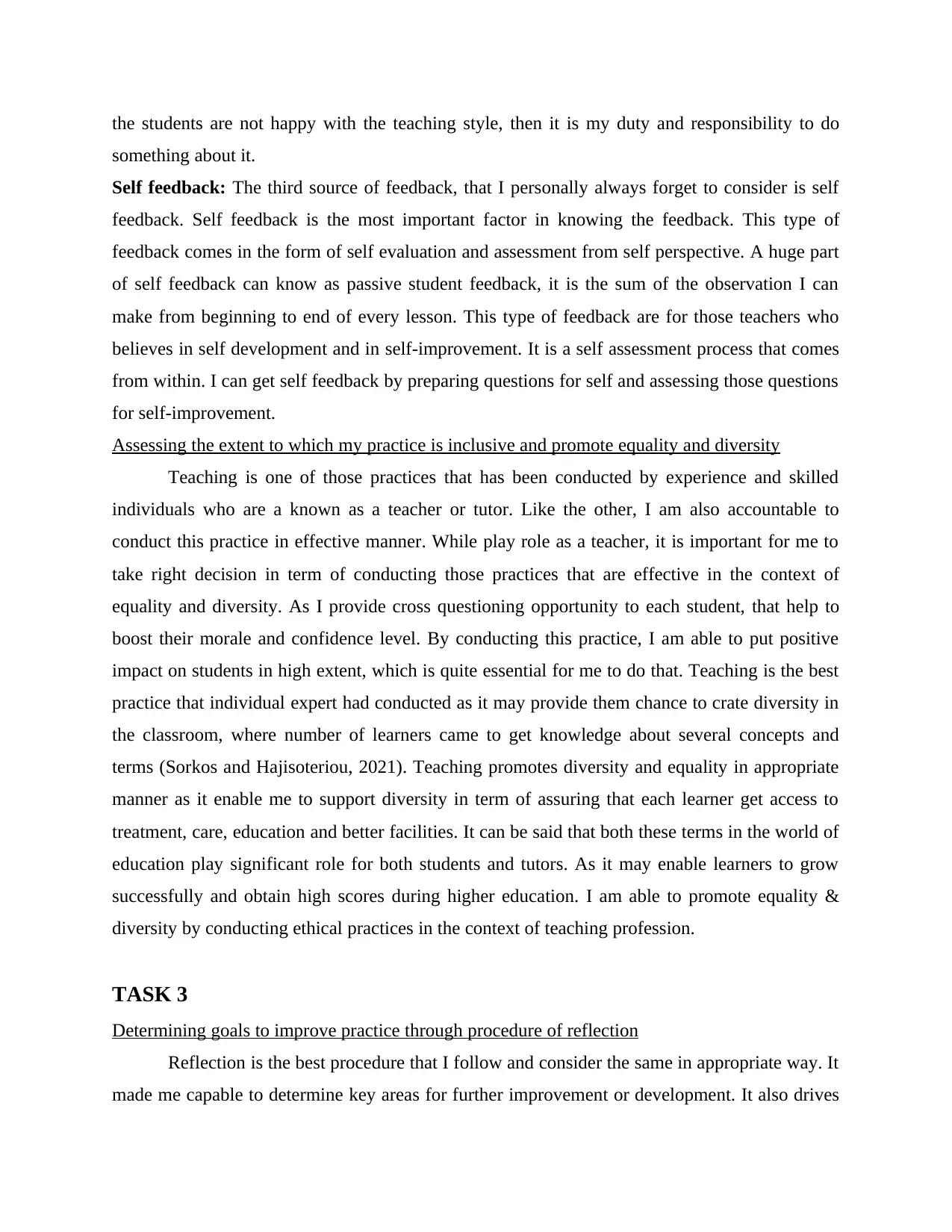
the students are not happy with the teaching style, then it is my duty and responsibility to do
something about it.
Self feedback: The third source of feedback, that I personally always forget to consider is self
feedback. Self feedback is the most important factor in knowing the feedback. This type of
feedback comes in the form of self evaluation and assessment from self perspective. A huge part
of self feedback can know as passive student feedback, it is the sum of the observation I can
make from beginning to end of every lesson. This type of feedback are for those teachers who
believes in self development and in self-improvement. It is a self assessment process that comes
from within. I can get self feedback by preparing questions for self and assessing those questions
for self-improvement.
Assessing the extent to which my practice is inclusive and promote equality and diversity
Teaching is one of those practices that has been conducted by experience and skilled
individuals who are a known as a teacher or tutor. Like the other, I am also accountable to
conduct this practice in effective manner. While play role as a teacher, it is important for me to
take right decision in term of conducting those practices that are effective in the context of
equality and diversity. As I provide cross questioning opportunity to each student, that help to
boost their morale and confidence level. By conducting this practice, I am able to put positive
impact on students in high extent, which is quite essential for me to do that. Teaching is the best
practice that individual expert had conducted as it may provide them chance to crate diversity in
the classroom, where number of learners came to get knowledge about several concepts and
terms (Sorkos and Hajisoteriou, 2021). Teaching promotes diversity and equality in appropriate
manner as it enable me to support diversity in term of assuring that each learner get access to
treatment, care, education and better facilities. It can be said that both these terms in the world of
education play significant role for both students and tutors. As it may enable learners to grow
successfully and obtain high scores during higher education. I am able to promote equality &
diversity by conducting ethical practices in the context of teaching profession.
TASK 3
Determining goals to improve practice through procedure of reflection
Reflection is the best procedure that I follow and consider the same in appropriate way. It
made me capable to determine key areas for further improvement or development. It also drives
something about it.
Self feedback: The third source of feedback, that I personally always forget to consider is self
feedback. Self feedback is the most important factor in knowing the feedback. This type of
feedback comes in the form of self evaluation and assessment from self perspective. A huge part
of self feedback can know as passive student feedback, it is the sum of the observation I can
make from beginning to end of every lesson. This type of feedback are for those teachers who
believes in self development and in self-improvement. It is a self assessment process that comes
from within. I can get self feedback by preparing questions for self and assessing those questions
for self-improvement.
Assessing the extent to which my practice is inclusive and promote equality and diversity
Teaching is one of those practices that has been conducted by experience and skilled
individuals who are a known as a teacher or tutor. Like the other, I am also accountable to
conduct this practice in effective manner. While play role as a teacher, it is important for me to
take right decision in term of conducting those practices that are effective in the context of
equality and diversity. As I provide cross questioning opportunity to each student, that help to
boost their morale and confidence level. By conducting this practice, I am able to put positive
impact on students in high extent, which is quite essential for me to do that. Teaching is the best
practice that individual expert had conducted as it may provide them chance to crate diversity in
the classroom, where number of learners came to get knowledge about several concepts and
terms (Sorkos and Hajisoteriou, 2021). Teaching promotes diversity and equality in appropriate
manner as it enable me to support diversity in term of assuring that each learner get access to
treatment, care, education and better facilities. It can be said that both these terms in the world of
education play significant role for both students and tutors. As it may enable learners to grow
successfully and obtain high scores during higher education. I am able to promote equality &
diversity by conducting ethical practices in the context of teaching profession.
TASK 3
Determining goals to improve practice through procedure of reflection
Reflection is the best procedure that I follow and consider the same in appropriate way. It
made me capable to determine key areas for further improvement or development. It also drives
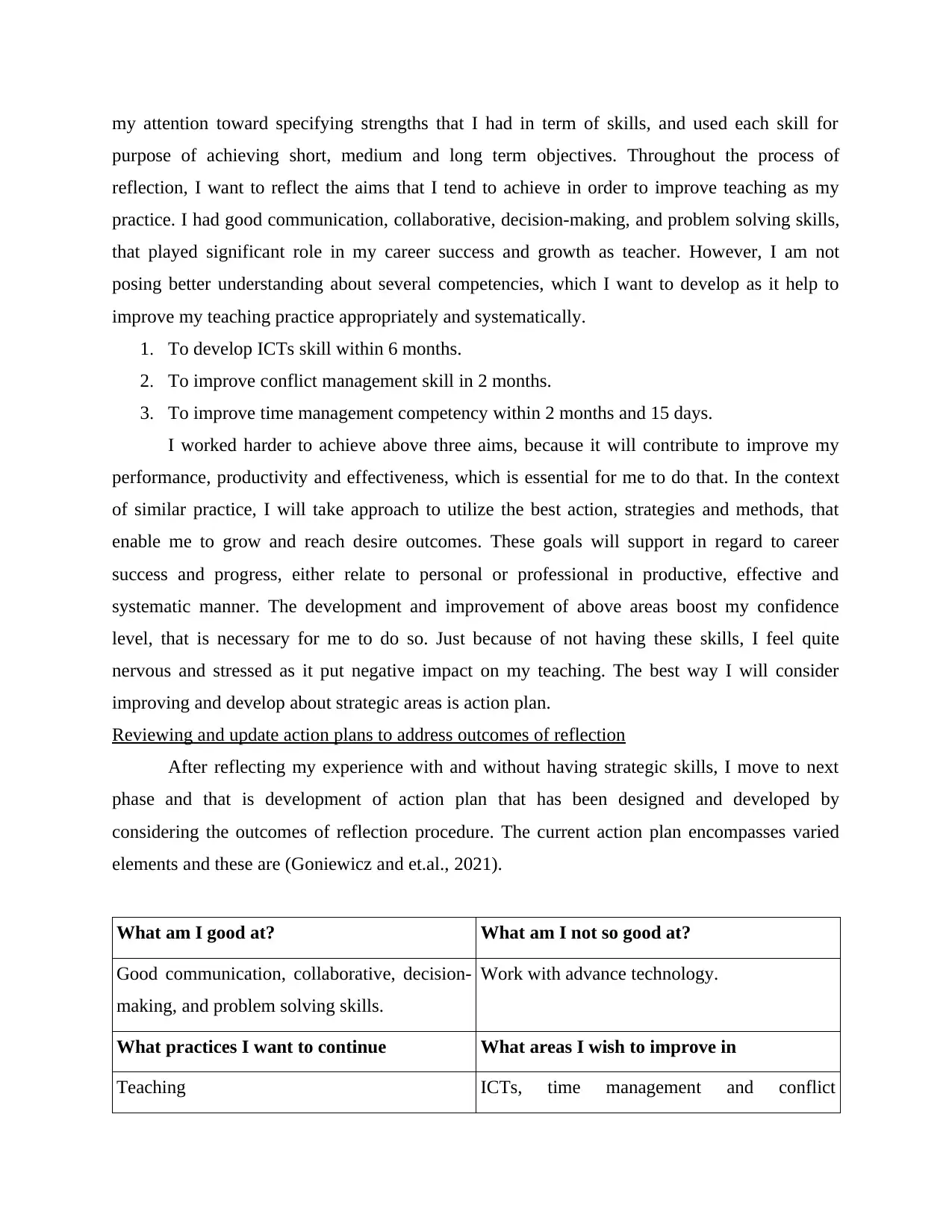
my attention toward specifying strengths that I had in term of skills, and used each skill for
purpose of achieving short, medium and long term objectives. Throughout the process of
reflection, I want to reflect the aims that I tend to achieve in order to improve teaching as my
practice. I had good communication, collaborative, decision-making, and problem solving skills,
that played significant role in my career success and growth as teacher. However, I am not
posing better understanding about several competencies, which I want to develop as it help to
improve my teaching practice appropriately and systematically.
1. To develop ICTs skill within 6 months.
2. To improve conflict management skill in 2 months.
3. To improve time management competency within 2 months and 15 days.
I worked harder to achieve above three aims, because it will contribute to improve my
performance, productivity and effectiveness, which is essential for me to do that. In the context
of similar practice, I will take approach to utilize the best action, strategies and methods, that
enable me to grow and reach desire outcomes. These goals will support in regard to career
success and progress, either relate to personal or professional in productive, effective and
systematic manner. The development and improvement of above areas boost my confidence
level, that is necessary for me to do so. Just because of not having these skills, I feel quite
nervous and stressed as it put negative impact on my teaching. The best way I will consider
improving and develop about strategic areas is action plan.
Reviewing and update action plans to address outcomes of reflection
After reflecting my experience with and without having strategic skills, I move to next
phase and that is development of action plan that has been designed and developed by
considering the outcomes of reflection procedure. The current action plan encompasses varied
elements and these are (Goniewicz and et.al., 2021).
What am I good at? What am I not so good at?
Good communication, collaborative, decision-
making, and problem solving skills.
Work with advance technology.
What practices I want to continue What areas I wish to improve in
Teaching ICTs, time management and conflict
purpose of achieving short, medium and long term objectives. Throughout the process of
reflection, I want to reflect the aims that I tend to achieve in order to improve teaching as my
practice. I had good communication, collaborative, decision-making, and problem solving skills,
that played significant role in my career success and growth as teacher. However, I am not
posing better understanding about several competencies, which I want to develop as it help to
improve my teaching practice appropriately and systematically.
1. To develop ICTs skill within 6 months.
2. To improve conflict management skill in 2 months.
3. To improve time management competency within 2 months and 15 days.
I worked harder to achieve above three aims, because it will contribute to improve my
performance, productivity and effectiveness, which is essential for me to do that. In the context
of similar practice, I will take approach to utilize the best action, strategies and methods, that
enable me to grow and reach desire outcomes. These goals will support in regard to career
success and progress, either relate to personal or professional in productive, effective and
systematic manner. The development and improvement of above areas boost my confidence
level, that is necessary for me to do so. Just because of not having these skills, I feel quite
nervous and stressed as it put negative impact on my teaching. The best way I will consider
improving and develop about strategic areas is action plan.
Reviewing and update action plans to address outcomes of reflection
After reflecting my experience with and without having strategic skills, I move to next
phase and that is development of action plan that has been designed and developed by
considering the outcomes of reflection procedure. The current action plan encompasses varied
elements and these are (Goniewicz and et.al., 2021).
What am I good at? What am I not so good at?
Good communication, collaborative, decision-
making, and problem solving skills.
Work with advance technology.
What practices I want to continue What areas I wish to improve in
Teaching ICTs, time management and conflict
⊘ This is a preview!⊘
Do you want full access?
Subscribe today to unlock all pages.

Trusted by 1+ million students worldwide
1 out of 19
Related Documents
Your All-in-One AI-Powered Toolkit for Academic Success.
+13062052269
info@desklib.com
Available 24*7 on WhatsApp / Email
![[object Object]](/_next/static/media/star-bottom.7253800d.svg)
Unlock your academic potential
Copyright © 2020–2025 A2Z Services. All Rights Reserved. Developed and managed by ZUCOL.





